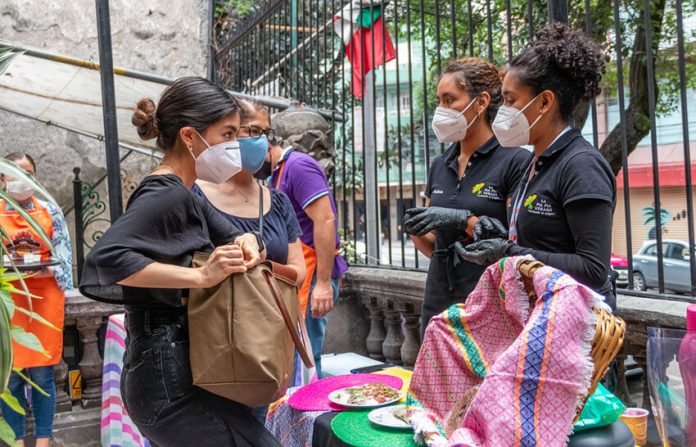The fifth wave of coronavirus infections began in Mexico in early May, according to experts who spoke with the newspaper El Universal, but the government waited until after the June 5 elections to say anything, said one.
Arturo Erdély, a National Autonomous University (UNAM) mathematician who has tracked Mexico’s COVID data throughout the pandemic, said it was clear that the fifth wave started at the beginning of last month. “Since the middle of May I’ve been saying that there were already very clear signs about the fifth COVID-19 wave but the government didn’t want to talk about it, perhaps for electoral reasons,” he said.
“Curiously,” Erdély added, the day after elections were held the government acknowledged that case numbers had increased and announced the return of daily COVID data reports.
Official data published Monday showed that active coronavirus case numbers had increased over 50% in the space of a week and almost 140% in the past two weeks. The Health Ministry reported 8,026 new cases Tuesday, a 377% increase compared to the average number of infections reported daily between May 29 and June 4.
Erdély said that the fifth wave is likely to peak this month and warned against not taking the COVID threat seriously. “We always have to be concerned about a virus that has shown a great capacity for mutation and adaptation. We have to be careful with the messages … that Deputy Health Minister Hugo López-Gatell gave in the sense that omicron isn’t so virulent,” he said.
“… Getting sick with COVID isn’t good even if [the illness] is mild, because it leaves consequences that deteriorate the quality of life,” Erdély said.
The mathematician predicted that far fewer people will die from COVID during the fifth wave because the disease has already claimed the lives of many those who were most vulnerable to getting seriously ill, such as the elderly and people with chronic health problems.
“We’re talking about 726,000 Mexicans who were the most susceptible to dying,” he said, referring to an excess death figure over the past two years rather than the official COVID-19 death toll, which is currently just over 325,000.

The number of COVID-19 deaths since early May is indeed low when compared with fatalities during Mexico’s first four waves. There were 708 deaths between May 3 – about the time the fifth wave started, according to experts – and June 7 for a daily average of just under 20. During the worst month for COVID-19 fatalities – January 2021, when the vast majority of the population was not yet vaccinated – Mexico recorded a daily average of 1,055 deaths.
While the daily death toll won’t return to such a high level, the number of new infections reported on a daily basis could approach the figures seen in the first three waves, if not those recorded in the fourth omicron-fueled wave, during which monthly case numbers peaked at almost 1 million in January 2022.
Infectious disease specialist Alejandro Macías said the BA.4 and BA.5 sub-variants of the omicron strain – which haven’t yet been detected in Mexico – will cause a lot of infections in the fifth wave. “What can we expect? As a lot of people already have immunity because they were already infected or got vaccinated or both, an increase in cases can be expected in Mexico but not a catastrophic situation,” he said.
The former health official – Mexico’s influenza czar during the 2009 swine flu pandemic – also predicted an increase in hospitalizations but asserted that fatality numbers won’t be as high as in previous waves.
Macías said that federal authorities have a responsibility to make it clear to citizens that the pandemic is not over. “The use of face masks indoors has to be promoted, people who haven’t completed their vaccination scheme should do so, enclosed spaces need to be ventilated and those who can work at home should continue to do so,” he said.
“Things like that are necessary to avoid the … [fifth wave] being very intense.”
Héctor Hernández Bringas, an UNAM academic with a doctorate in population studies, described the number of new cases reported in the seven-day period to June 6 – 18,539 – as a “significant quantity.”
“Infections, deaths and hospitalizations decreased in March and April, leading to some assertions that we were …[at the] end of the pandemic, a mistaken message that resulted in a greater relaxation of prevention measures on the part of the public,” he said.
![]()
Hernández blamed municipal, state and federal authorities for poor pandemic messaging. “They tell us to forget about face masks. In fact there were orders in that sense,” he said, referring to the termination of mask mandates in some states. “In a nutshell, there have been messages that have caused people to be careless,” the academic added.
“We all want life to return to normal, for children to go to school and for people to return to their workplaces, and this is already occurring. But that might also be part of the reason why we’re seeing a new wave. We have to be more cautious in resuming the activities we considered normal before the pandemic,” Hernández said.
Laurie Ann Ximénez-Fyvie, director of the Molecular Genetics Laboratory at UNAM and author of a book about the government’s “criminal management” of the pandemic, said that it’s difficult to make predictions about the fifth wave because the risk posed by omicron sub-variants is not yet fully understood.
She warned that infants up to the age of two and the elderly, especially those with chronic diseases, are most vulnerable to dying if they become infected. “But the main risk of death from COVID-19 comes from not being vaccinated,” Ximénez-Fyvie added.
About 70% of Mexicans are vaccinated but the government hasn’t offered shots to children under 12.
With reports from El Universal and El Financiero
